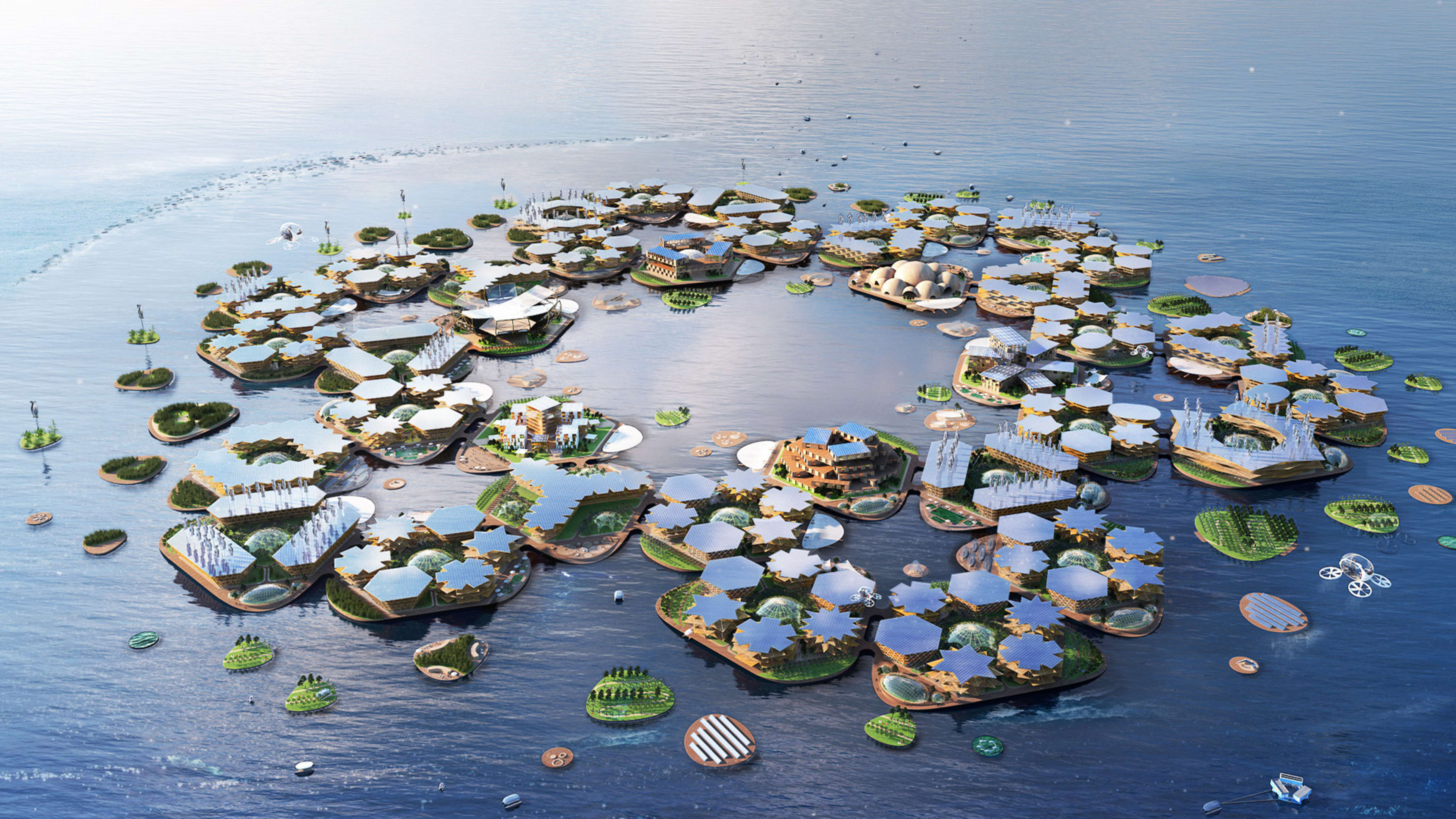In 2007, entrepreneur Marc Collins Chen became the minister of tourism in his native French Polynesia. One of his first tasks was to assess whether sea level rise was a threat to the group of 118 islands, located in the South Pacific. He quickly learned that one-third of all of the French Polynesian islands would be submerged by either 2035 or 2050–depending on which scientist you spoke to.
To respond to the coming crisis, Chen (who served as minister of tourism for a year) wants to build groups of floating islands that would be able to act as new human settlements not only for French Polynesia, but for the countless other islands that will suffer a similar fate–as well as the many global cities that are located on the coast. An estimated 2.4 billion people–40% of the world’s population–live in a coastal region and will likely be impacted by rising sea levels as a result of climate change. In late 2018, Chen started a company called Oceanix that is aimed at building the off-shore urban infrastructure that will help people weather the problems of rising seas–as well as extreme floods and storms.
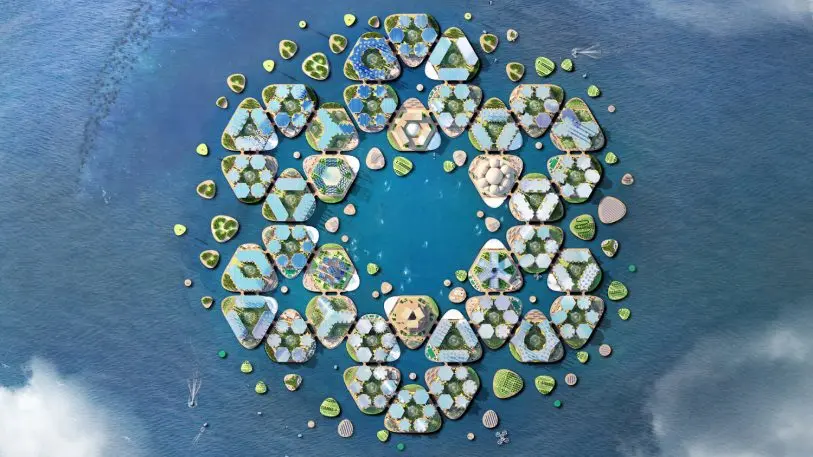
This week, Chen and a group of collaborators ranging from famed architect Bjarke Ingels to experts in zero waste, water engineering, mobility, and energy-efficient design unveiled plans for what a sustainable floating city might look like at the United Nations in New York. They laid out a plan based on 4.5-acre hexagonal floating islands–about the size of three and a half football fields–that each houses 300 people. “This becomes the basic molecule of a sharing urban system,” Ingels said.
Combining six of these islands forms a small village around a central open port, with each island having some kind of dedicated communal use–like healthcare, education, spirituality, exercise, culture, and shopping. Then, if you continue to scale up and loop six villages together, you end up with a small city of 10,800 people. Outside the floating city there would be small uninhabited islands with dedicated purposes, like to collect energy from the sun or to grow food. These would also double as a buffer against waves and wind.
The UN hasn’t formally endorsed the project, but the design team’s presence at the organization’s headquarters lends legitimacy to an idea that in previous years might’ve seemed like science fiction. The assistant secretary-general and deputy executive director of UN Habitat Victor Kisob said in his opening remarks that “all solutions must be considered in how we build cities . . . . It’s our duty to make sure this burgeoning sector is mobilized for the good of all people.”
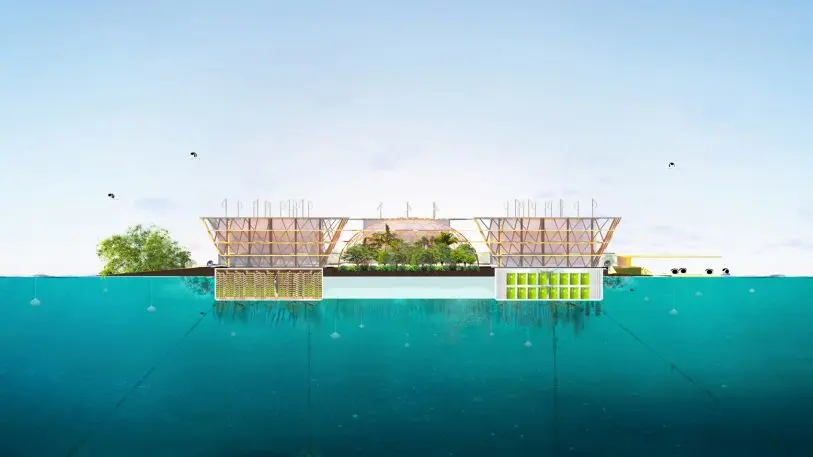
Floating cities are not new, and in fact, the idea goes all the way back to the Aztecs. Architect Buckminster Fuller also planned a floating city in the ’60s. There are floating neighborhoods in the Netherlands, and the Peter Thiel-backed Seasteading Institute wants to build floating islands that are free from government control.
What separates Oceanix’s plan from many other plans is scalability. If Oceanix can figure out how to make one village of hexagonal islands work, the system could theoretically be duplicated endlessly. “There are already many iterations of floating homes and apartments, but there’s no integrated vision for how this is going to scale,” Chen said at the event. Oceanix hopes to engineer a floating city system that is entirely closed loop. That means that all the food for everyone who lives there is grown on the man-made islands, all the water is captured there, all the waste is reused, and all of these fundamental operations only use energy that can be harvested by the floating city itself. The idea is hugely ambitious, given that few cities manage to achieve one, let alone all of these goals.
The plan is to start prototyping these hexagonal floating modules, which would be anchored about a mile off the coast of major global cities, starting close to the equator where the weather is warmer, and the designers can build a city that is mostly outdoors (floating cities are a much harder sell if it’s going to snow). Each island would be anchored to the bottom of the ocean using a material called biorock, which uses low voltages of electricity to stimulate the growth of limestone out of ocean mineral deposits–the material is ecologically friendly and is currently used to facilitate the growth of coral reefs.
For Ingels, who has been interested in floating city concepts for many years and recently built floating student housing out of shipping containers in Copenhagen, a key concern was ensuring that the floating islands would be desirable places to live–on top of being scalable and sustainable. The renderings for the team’s concept look nearly utopian, with people walking, greenery everywhere, and beautifully designed small-scale buildings. “This doesn’t look like Manhattan. There are no cars,” Ingels said.
Instead, Ingels said, “Imagine a community port where you have a market down by the sea, where you can go in the evening and stroll and hang out, where you can move around on electrical nautical vehicles on this bazaar-like street along canals that connect and separate islands,” he said. “This same configuration can be the canvas for any culture. What you’re designing is an urban social infrastructure.”
It’s a remarkably ambitious idea. But could it really work? Here’s a closer look at the plan.
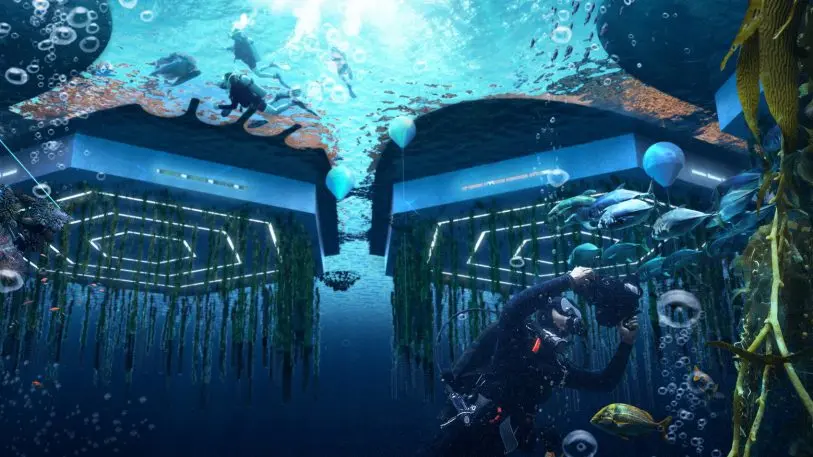
You drink water drawn from the air, the sky, and the sea
For each crucial system necessary to maintain human life in a floating city, Oceanix and BIG brought in subject matter experts. Perhaps the most important system to consider first? Water.
S. Bry Sarte, the cofounder and CEO of Sherwood Design Engineers, proposes a system that aims to collect water from the sky, the sea, and even the air. That means collecting every drop of rainwater that falls onto the floating city by using every paved surface and roof to capture the water and direct toward somewhere it can be stored–this is the most ideal water source because it requires no energy to collect. A second water source would be the ocean. BIG’s concept includes a water desalination plant on the underside of the floating city.
On top of that, the team is looking into machines that can pull humidity out of the air: There are many iterations of this kind of device that have been tried and tested, even if they’re not common place. These could be particularly effective in the tropical climates where the first Oceanix cities would be prototyped.
But gathering water isn’t the only challenge–the islands would also need to store it. Sarte proposes using floating storage containers that can can expand and contract based on how much water they’re holding at any given time. Then there’s wastewater. The team is also exploring ways to treat as much graywater as possible so it can be reused. One idea? To collect graywater in natural pools, where it can be filtered through a biological system. These pools would also add to the aesthetic beauty of the islands.
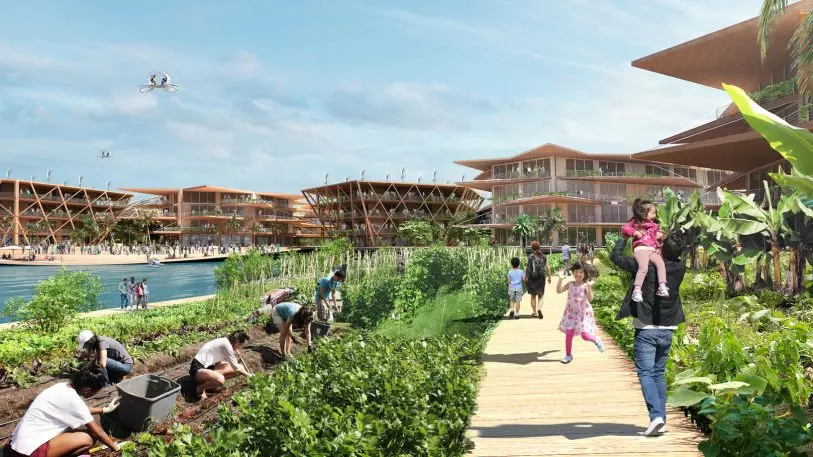
All food would be grown on the floating islands
For Oceanix’s idea to work, all the food needed to feed every person living in the floating city would need to be grown there. What does that mean? There’s certainly no meat involved, mostly because beans are a far more efficient way of getting protein. Some crops would be grown outdoors–an estimated 32,000 square feet on each hexagon would be devoted to food cultivation. Much of that would be outdoors, since the sun uses the least amount of stored energy, and the crops would double as green space for residents.
But according to Clare Miflin, the cofounder of the Center for Zero Waste Design, a floating city would also need to experiment with other ways of growing food. One possibility: outdoor vertical farming for crops like lettuce. Then there’s hydroponics and aeroponics, the latter of which uses 10 times less water than traditional farming simply by spraying plant roots with mist. Aquaponics, in which plants grow hydroponically and are fertilized with fish waste, has a deep precedent–the Aztecs used aquaponic farming on their own floating agricultural islands many centuries ago.
With food comes food waste. Miflin wants to create a circular system where all food waste is turned into nutrients for the soil through composting. Food waste would go through a pneumatic system of pipes directly to an anaerobic digester to start the composting process. But there’s also the problem of packaging. Miflin believes that it would be crucial for the floating city to only use reusable food containers, with centrally located drop-off points for people to put their empty containers; from there, they could be cleaned centrally and reused.
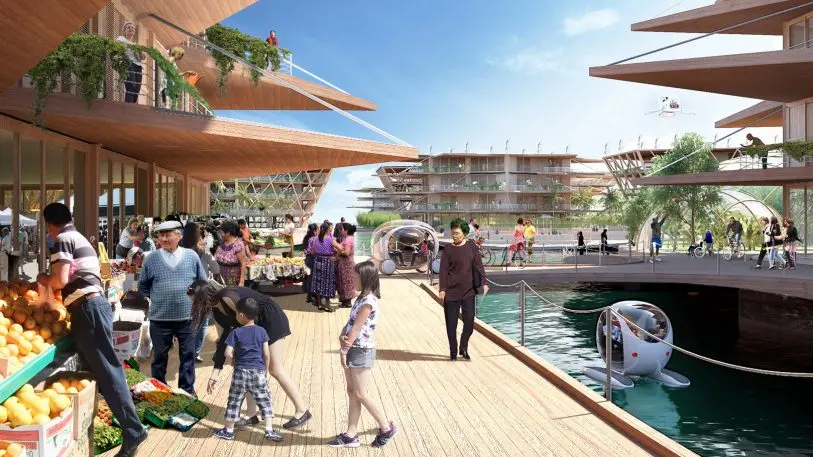
The sharing economy comes to everything
Miflin thinks that the mentality of reusing food packaging would have to apply to all objects on the floating city. That means that a sharing-based economy for goods would dominate. You’d be able to borrow much more than books from the library–you’d also be able to borrow everything from drills to a bike. People would lease more expensive items like personal electronics or computers rather than buying them, and just return them to the store when they are finished so the materials can be refurbished and reused. “Everything will be rented rather than owned,” Miflin said.
That also means that everything would need to be designed to be repaired and eventually disassembled. Whether it’s a building or a chair, things would need to be broken down and made into something new rather than simply discarding them.
When something has absolutely reached the end of its life, the waste would be sent through the pneumatic tubes or put into a reusable bag, tagged with a RFID sensor to track where the waste came from, and then whisked away to a sorting center. All this waste would be metered–just like we meter electricity and water today to measure how much we’re using. Miflin believes this would incentivize people to cut down on their waste as much as possible.
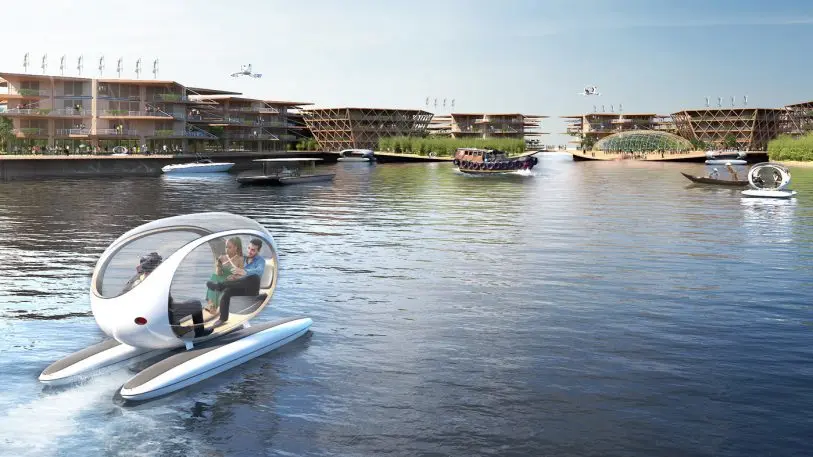
To get around, you’d mostly walk–or take an electric boat
BIG’s design attempts to make these futuristic communities as walkable and bikeable as possible. According to Federico Parolotto, the cofounder and senior partner at the firm Mobility in Chain, which consulted on the project, the design allows for 60% of all trips to be made using sustainable transportation modes–either walking or biking. Everything else would be through shared electric vehicles, some of which would travel within each floating hexagon, and some of which would motor around on the city’s canals.
This is possible in part because each village’s area is so small: iIt’s less than two miles around each one. The distance is closer in scale to the size of neighborhoods before cars–and the team envisions that having a smaller community would have a positive impact on how much people would really need extensive, energy-draining transportation options.
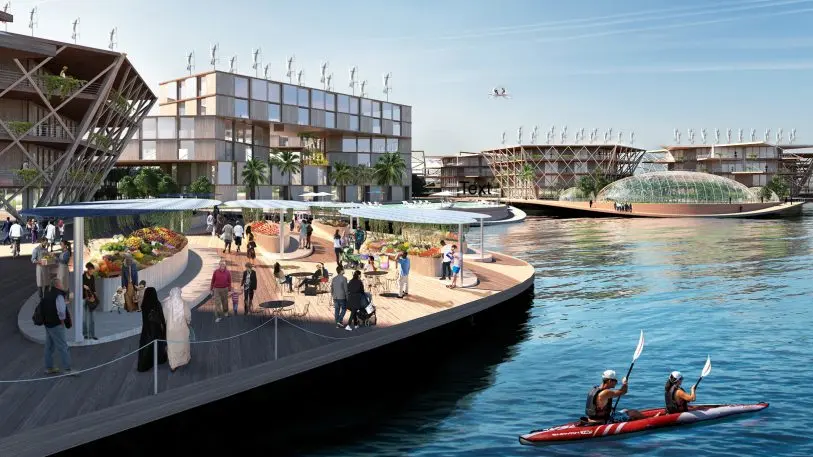
Everyone would have a personal energy budget
That brings us to energy. Every other system–food, water, waste, transportation–ultimately feeds into energy. Erik Olsen, the managing partner at Transsolar KlimaEngineering, thinks that for floating cities to be viable, each resident would need to have an energy budget–something that will make everyone think twice about what they really need to use energy for.
That budget would be their share of all the energy that the city can generate on its own, using solar power, wind, and even generating energy from ocean waves. A key way to reduce energy use? Minimize how much electric transportation people use (why the floating cities would be designed to be walkable). The biggest energy suck is actually agriculture, particularly indoor agriculture. Growing food outdoors would be crucial to minimize energy usage in general. On top of that, buildings, especially in the tropics, can be much more porous and use far less air-conditioning than they do currently. Olsen pointed to a building at the National University of Singapore’s School of Design & Environment, which his firm engineered to use as little energy as possible, as an example of how it could be done. “It has very different expectations for comfort but is net energy zero,” he said.
Ultimately, Olsen thinks that having an energy budget per person would only work if the low-energy choices are just as good as the high-energy choices. “The goal here is very much to highlight how do we make the energy-efficient choice not a compromise, but a better choice that makes it preferable,” he said.
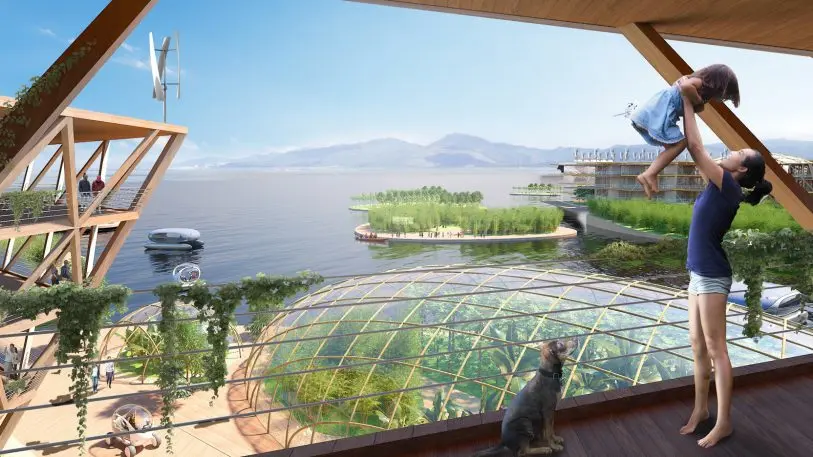
Is any of this feasible?
It’s hard to say whether Oceanix will be able to pull off a project of this magnitude and complexity, let alone scale it. There are hosts of problems yet to be figured out, and much of the technology to make this happen will need to be either invented from scratch or wholly adapted to fit the floating city. And though there are a host of green infrastructure venture capital funds as well as government programs aimed at encouraging sustainable development, Oceanix hasn’t provided much detail about its business plan, so it’s unclear how, or even whether, it could fund the project.
There’s also the issue of equity and inclusion: Chen said one of his core goals for Oceanix is to make it affordable, but it’s unclear how he plans to achieve that, especially given the amount of work that would go into creating the very first prototype. Who will govern these places? Will they have their own elected officials in the city government closest to them, or will they have their own governments? How will they fit into the greater economy? What will people do for jobs on floating cities? Will they have to commute to the mainland? The questions are nearly endless. But that’s also part of the point. We live in times that call for big, wacky ideas that aim to completely flip the paradigm of how humans live now.
Chen hopes that Oceanix’s idea will jump-start the development of more sustainable technology, creating a whole ecosystem of solutions that could be applied elsewhere. That is perhaps the project’s biggest ambition: that some of the technologies developed for these floating cities could then be used to improve regular cities, too. “As you start thinking about recycling water and waste, there’s no reason why what you learn would not apply to conventional [places]–where 90%, 95%, or 98% of people will be living,” said the famed economist and Nobel Prize winner Joseph Stiglitz, who joined in the UN discussion.
Ultimately, Oceanix and BIG’s hope is that living on a man-made island might be just as attractive as living on land–but it’s not something the team anticipates replacing normal patterns of human habitation entirely. “The idea that we’re presenting is not that we will all be living at sea in the future. It won’t be Waterworld, that Kevin Costner had limited success at imagining,” Ingels said. “This is simply another form of human habitat. It can be a seed that can grow with its success.”
Recognize your brand’s excellence by applying to this year’s Brands That Matter Awards before the early-rate deadline, May 3.
